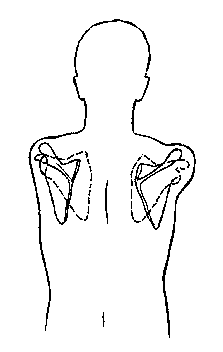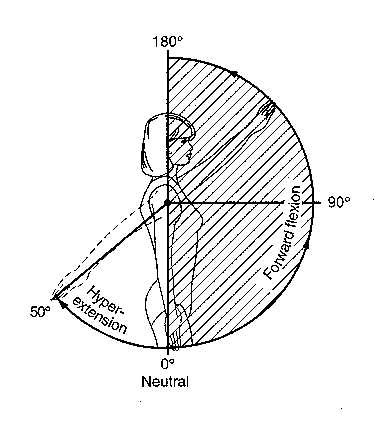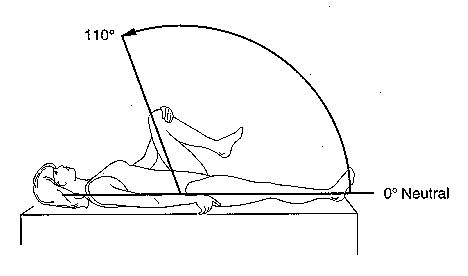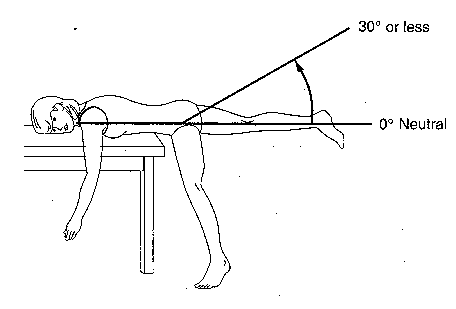Joint Range of Motion Testing
![]()
Before you proceed, click here and print out the worksheet for this report.
![]()
Introduction
Joint flexibility is defined as the range of motion (ROM) allowed at a joint. A joint's ROM is usually measured by the number of degrees from the starting position of a segment to its position at the end of its full range of the movement. The most common way this is done is by using a double-armed goniometer. A stationary arm holding a protractor is placed parallel with a stationary body segment and a movable arm moves along a moveable body segment. The pin (axis of goniometer) is placed over the joint. When anatomical landmarks are well defined, the accuracy of measurement is greater. If there is more soft tissue surrounding the joint area, measurement error can be more frequent.
Purposes
The purpose of this Report is to measuring the ROMs of the major joints in our body using a double-armed goniometer. Note the terms used to describe different joint motions allowed at the major joints of the body.
Measurements
Stage 1: Shoulder Girdle Movements & ROM
Stand behind a subject who has removed clothing from the waist up. Palpate the inferior angle and the vertebral border of the scapula (Figure 1).
Have the subject slowly abduct his/her arm at the shoulder joint.
1. Record the number of shoulder joint abduction at the point the scapula starts moving.
2. How many degrees will the scapula move if the arm continues in abduction (Figure 1)?
3. What is the name of this scapula movement?

FIGURE 1. Scapula Movements (Adapted from Luttgens &
Hamilton, 1997)

FIGURE 2. Lateral Motion of the Scapula (Adapted from Luttgens & Hamilton, 1997)
Now, have the subject slowly flex his/her arm at the shoulder joint to 90° flexion.
4. Record the number of degrees of shoulder joint flexion at the point the scapula starts moving.
5. Have the subject move to 90° of shoulder joint flexion. How many centimeters will the scapula (inferior edge) move laterally (Figure 2)?
6. What is the name of this scapula movement?
Stage 2: Shoulder Joint ROM
7. With the shoulder joint abducted to 90° and the elbow flexed, determine the ranges of internal and external rotations (Figure 3).
8. Determine the amount of hyperextension.


Figure 3. Medial & Lateral Rotation of the Shoulder
(Adapted from Luttgens & Hamilton, 1997)
Stage 3: Elbow Joint ROM
9. Determine the range of motion (flexion) at the elbow (Figure 4).
10. How many degrees of hyperextension of the elbow?

FIGURE 4. Elbow Joint Motions (Adapted from Luttgens &
Hamilton, 1997)
Stage 4: Wrist Joint ROM
11. How many degrees of wrist flexion (Figure 5)?
12. How many degrees of wrist hyperextension?
13. How many degrees of wrist radial deviation?
14. How many degrees of ulnar deviation?


FIGURE 5. Wrist Joint Motions (Adapted from Luttgens &
Hamilton, 1997)
Stage 5: Hip Joint ROM
15. Determine the amount of (right) hip flexion. You will place the goniometer pin on the greater trochanter of the femur (Figure 6). Measurement is most accurate with the subject lying supine and flexing the right hip by raising one leg in the air (both knees remains in extension).
16. Determine hip flexion when the moveable segment has 90° of knee flexion.
17. Determine the amount of hip hyperextension. The subject will assume a prone position for this measurement.


FIGURE 6. Hip Joint Motions (Adapted from Luttgens &
Hamilton, 1997)
Stage 6: Knee Joint ROM
18. Determine the amount of knee flexion. The easiest measurement technique is to again have the subject be prone (Figure 7).
19. Determine the amount of knee hyperextension. Have the subject sitting on a bench with the legs out in front. Elevate the feet so that the leg is not resting on the surface.

FIGURE 7. Knee Joint Motions (Adapted from Luttgens &
Hamilton, 1997)
Stage 7: Ankle Joint ROM
20. Determine the amount of dorsal flexion and plantar flexion (Figure 8).

FIGURE 8. Ankle Joint Motions (Adapted from Luttgens &
Hamilton, 1997)
Summary
Improving joint flexibility is essential for injury prevention. One may increase joint flexibility (range of motion) by regular stretching. NOTE that too much flexibility may lead to injuries. What are the factors affecting flexibility of a joint? Table 1 summarizes the average ROMs published. Compare your measurements with these values. Are they in similar ranges or not? If not, why?
TABLE. 1 Average ROMs (Adapted from Luttgens & Hamilton, 1997)
| Joint/Segment | Movement | Source 1* | Source 2* | Source 3* | Source 4* |
| Elbow | Flexion | 140 | 145 | 145 | 145 |
| Hyperextension | 0 | 0 | 0 | 0-10 | |
| Forearm | Pronation | 80 | 90 | 90 | 80 |
| Supination | 80 | 85 | 90 | 90 | |
| Wrist | Extension (Dorsiflexion) | 60 | 70 | 70 | 50 |
| Flexion (Palmar flexion) | 60 | 90 | - | 60 | |
| Radial Deviation | 20 | 20 | 20 | 20 | |
| Ulnar Deviation | 30 | 30 | 35 | 30 | |
| Shoulder | Flexion | 180 | 170 | 130 | 180 |
| Hyperextension | 50 | 30 | 80 | 60 | |
| Abduction | 180 | 170 | 180 | 180 | |
| Adduction | 50 | - | - | - | |
| Shoulder w/ Abducted Arm |
Internal Rotation | 90 | 90 | 70 | 60-90 |
| External Rotation | 90 | 90 | 70 | 90 | |
| Horizontal Adduction | - | - | - | 135 | |
| Horizontal Adduction | - | - | - | 45 | |
| Hip | Flexion | 100 | 120 | 125 | 120 |
| Hyperextension | 30 | 10 | 10 | 30 | |
| Abduction | 40 | 45 | 45 | 45 | |
| Adduction | 20 | - | 10 | 0-25 | |
| Extended Hip | Internal Rotation | 40 | 35 | 45 | 40-45 |
| External Rotation | 50 | 45 | 45 | 45 | |
| Knee | Flexion | 150 | 120 | 140 | 130 |
| Ankle | Plantar flexion | 20 | 45 | 45 | 50 |
| Dorsiflexion | 30 | 15 | 20 | 20 | |
| Cervical Spine | Flexion | 60 | - | - | 40 |
| Hyperextension | 75 | - | - | 40 | |
| Lateral Flexion | 45 | - | - | 45 | |
| Rotation | 80 | - | - | 50 | |
| Lumbar-thoracic Spine | Flexion | 45-50 | - | - | 45 |
| Hyperextension | 25 | - | - | 20-35 | |
| Lateral Flexion | 25 | - | - | 30 | |
| Rotation | 30 | - | - | 45 |
References
Luttgens, K. & Hamilton, N. (1997). Kinesiology: Scientific Basis of Human Motion, 9th Ed., Madison, WI: Brown & Benchmark.
![]()
Questions of comparison
1. What are the similarities in structure & function in the shoulder joint & the hip joint?
The hip and shoulder are both ball and socket joints.
2. State reasons why the shoulder joint has a wider range of motion than the hip joint even though the articulation areas are structurally similar.
The hip is a weight bearing joint and the cup that it sits in is deeper. The hip joint is more stable as it supports the body above it. The shoulder has more flexibility as it is not as deep. The shoulder moves as a hinge as well as a ball and socket.
3. What are the factors that influence range of motion of a joint?
The physical anatomy like the joint capsule, ligaments, tendons or muscle bellies that cross the joint and the shape of the points of the bones that meet (saddle joint, ball and socket joint, hinge joint and so forth).
You could have a scar tissue from surgery or trauma that limits it.
Trauma has memory in the brain and in the golgi tendon complexes that limit range of motion.
The lifestyle of each person limits their range of motion according to their physical activities. Certain activities increase and other activities decrease flexibility.
4. Explain why we lose flexibility.
Flexibility is often lost through trauma, disease, or inactivity. The phase use it or lose it is quite literaly true with the physical body.
Lifestyle and the choice of how to maintain our flexibility become more important as we age.
5. How is flexibility related to the likelihood of injury?
We are most likely to injure ourselves when our posture or alignment is off. The body is strongest when it forms ninety degree angles at each of eight support points -- the shoulder, the hips, the knees, and the ankles become absorbers of force. The position of the feet, the head, and the spine are equally important. Many sports teams today tune up their athletes with posture checks at the beginning of the season to avoid injuries.